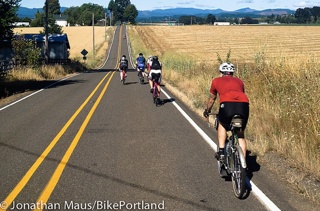
27 miles of rural roads this summer.
(Photo J. Maus/BikePortland)
Washington County road crews are gearing up for several major chip seal projects that will impact popular rural roads during the peak summer riding season.
For the county, chip seal is a way to extend the life of road surface and save them money in repairs and maintenance in the long-run; but to people who love riding on smooth roads, it means more bumps due to the tiny little rocks (chips) that are laid down in the process. The projects also mean that the roads will be closed briefly during and immediately after the work is completed.
Washington County is aware of these issues and they mention bicycling and offer this explanation of the chip seal process on their website:
Bicyclists may want to avoid roads during and immediately after chip sealing. During the chip seal process, the road surface is covered with an emulsified asphalt and small rocks (chips). A roller presses the chips into the emulsion, and the surface is swept several times to remove most of the loose material. To reduce the amount of loose chips even more, a polymerized (stickier) asphalt is used. The process is completed with a fog seal, which is a thin film of liquid asphalt and sand. The fog seal fills small voids, providing a smoother surface.
We recognize that this road work causes some short-term inconvenience. Please keep in mind that the result is a long-term benefit to all road users, including bicyclists.
Here’s a map we made showing some of the popular routes on the chip seal list:
And here’s the complete list:
- Aten Road from Pleasant Valley to dead end (west)
- Hillside Road from Kansas City to Clapshaw Hill
- Kemper Road from Hwy 47 to Kansas City
- Old Cornelius Pass Road from Cornelius Pass to Multnomah county line
- Pleasant Valley Road from Scholls Ferry to end of pavement
- Pumpkin Ridge Road from Shadybrook to end of pavement (Murphy)
- Spring Hill Road from Yamhill county line to Hwy 47
- West Union Road from Helvetia to Glencoe
- Woolen Road from Sellers to Green Mountain
The work is expected to last through August. If you plan to ride in these areas, your best bet is to check WC-Roads.com for the latest project updates or call (503) 846-ROAD (7623) before you head out.
For more about how chip seal impacts bicycling, read this 2011 blog post from Kent Peterson.


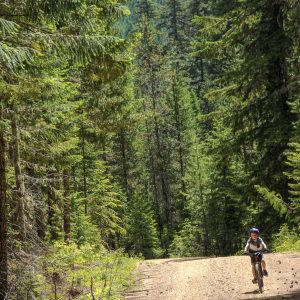
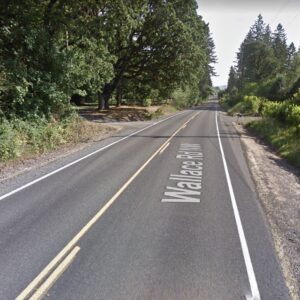
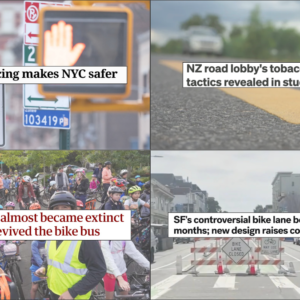
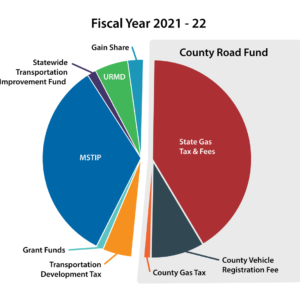
Thanks for reading.
BikePortland has served this community with independent community journalism since 2005. We rely on subscriptions from readers like you to survive. Your financial support is vital in keeping this valuable resource alive and well.
Please subscribe today to strengthen and expand our work.
NOOOOOO!
https://www.youtube.com/watch?v=umDr0mPuyQc
Ever notice that chip sealed roads dont throw up road spray? Thats because they dont. Winter rides are more pleasant on chip seal for this reason.
Run 25s with lower pressure, problem solved!
This is a place where you can’t say high heels are bad footwear for cycling, much less flip-flops.
Just for the record, I’d totally rock 25s if I could.
This blasè attitude points to the crux of the problem: some people bicycle because the have to not just for leisure. If all bicycle use was recreational, as WashCo’s statement assumes, then just not biking there would be a reasonable request.
The reality is that with a bicycle’s reduced range versus an automobile these sorts of detours are like shutting down the Freemont and Marquam Bridges and ODOT declaring that everybody can just go over the Sellwood Bridge.
Repeat after me Washington County transportation planners:
“A bicycle is a valid mode of transportation not a toy and are required, by law, to be planned for and accommodated along with motorized traffic.
“People on bicycles are taxpayers in Washington County, citizens of Washington County, employees of companies based in Washington County and are deserving of the same respect you give to a driver of an over-sized SUV that has never touched dirt and only ever carries 1 person.”
For rural roads though (which these are, right?) this is usually the case. Not a lot of farmers out commuting to work on a bike.
For rural roads it’s even worse as there are fewer roads to reroute to.
A detour that might add a ¼-½ mile to a trip in a city grid may add from 5-15 miles if to have find another way simply because there much fewer roads in the rural emptiness and fewer still that duplicate routes.
Quite frankly it is very normal in back country livin’ for there to be ONE main drag and when it is blocked all hell breaks loose.
650b randonneur bikes lookin’ good to anyone yet?
How do they determine which roads get chip sealed?
As an example Dairy Creek Rd gets minimal traffic, shows now signs of wear or degradation gets chip sealed. Kerkman Rd which has all of 5 residences on it and was a pristine piece of asphalt get chip sealed last year. Zion Church west of Glencoe was done and all I can say is that the description of what they lay down and what actually was done are far from the same. The size of “chip” used was monstrous and there wasn’t any sand laid on top to infill.
It seems like they are doing this on a schedule rather than based on need. How much does it cost to have someone inspect the road and determine it can wait another year or two. Right now they appear to be saving money over full repaving, while they could save even more by delaying even the chip seal.
How? They go out for three martini lunches with suits from the Asphalt Pavement Association of Oregon in between legislative sessions.
Some time last year, somebody…could have been you…asked in bikeportland’s forums, about Washington County’s chipsealing.
Having heard that he himself rides quiet a lot, I sent an email out to Commissioner Dick Schouten, asking about chipseal. Roughness of chipseal compared to that of hot asphalt laid down and rolled out was the issue people commenting in the forum discussion were displeased with. And not understanding what the county’s criteria for determining when a give road should be given the treatment. Not sure I asked him directly in the mail, what his personal feelings were, as someone who may have actually ridden on roads the county had applied the chipseal procedure to.
At any rate, his reply said the mail was given to a staffer to research and answer the questions. Information the staffer supplied, basically described the size of gravel the county is said to be using in its chipseal. Also, that the chipseal surface was expected to smooth out in time as heavy vehicles passed over it. Bottom line, is that the county says using chipseal helps stay within the budget. To that forum discussion, I posted the text of the letters sent and received.
Commissioner Dick Schouten has replied in past to various bikeportland stories. Maybe he’ll happen to read this one, and be able to offer some new information to reassure people about chipseal.
Chip seal is preventative maintenance to keep the road surface from deteriorating. It is applied BEFORE signs of pavement failure begin to appear. So yes, it is on a schedule rather than being based on inspection.
But is it the right schedule.
My car requires that my brake fluid be replaced on a three year schedule because it deteriorates whether I drive the vehicle or not.
My brake pads on the other hand need to be replaced regularly but that schedule is based on how many miles I drive and whether I spend my time in stop and go city traffic or highway driving and whether I brake in an aggressive manner.
If they are using a time schedule lets say every five years some type of resurfacing must be done and they do not take into account traffic volume and traffic type (passenger cars vs commercial trucks), then they are wasting a lot of money on chip sealing. Spending some cash to actually look at the road and do a traffic survey would save thousands of dollars by determining that even though the road is five year old it is not in need of preventative maintenance to the level of chip sealing.
“…Spending some cash to actually look at the road and do a traffic survey would save thousands of dollars by determining that even though the road is five year old it is not in need of preventative maintenance to the level of chip sealing.” meh
An official word from the county, as to whether or not it does in fact directly inspect roads for indication of need for paving, apart from simple timeline scheduling, could be of help. Also, an official description of what pavement condition indicate need for repaving exists.
Chip seal is the way the county has decided to go to stay within the budget. Maybe some thought could be put towards budget viability of designating for continued hot asphalt pavement, roads on a number of key routes particularly suited for biking.
See the light, roadies–the fattest tire that’ll fit in your bike is the best one for our current road environment.
They could be adding curb cuts to the new trails put in by THPRD, but apparently that’s not in the budget.
There are probably Parks vs. Transpo issues with sharing money like that, but if there were an adopt-a-cut program, I’d almost be willing to pay for one myself…
Not sure you’d want to do that. According to the email I received, it would have to go through “a very costly and extensive process”.
Hence “almost”. I imagine something that should cost $5,000 could be made to cost $26,000 easily. What costly process is involved in making a curb cut and adding the yellow knobbies? Do they actually cut it, or bust it out and re-pour a contoured “cut”? Is it the yellow tactile surface and its installation that costs so much? Or are they talking about widening the sections of trail that new cuts would be made for (3 feet wide isn’t quite enough for a MUP)?
My biggest beef with Chip seal is that usually municipalities do not actually fix holes/cracks/etc and just chip seal over them. This often makes them very hard to see, since the surface looks the same, with no breaks. Hit a few bumps this way in Colorado and almost got bucked off a few times.
Don’t see the problem. I ride chip sealed roads all the time, that’s all there is on our part of the Olympic Peninsula. It is an inconvenience during the process, as any road maintenance is. I am riding on 1.75″ X 26″ tires on a ’91 Bridgestone CB-1.
why?
they state what the process is that they do…
but, I don’t see them state why they suggest that bicyclists (and not all road users) avoid the road…
seems like a bad PR move to just put a blanket over all bicycles without any stated reason… shouldn’t cars with new paint also avoid the road?
what about somebody riding a Surly Moonlander? why should they avoid the road?
they need to give us a reason if they’re going to tell us to avoid the road…
are they afraid of the backlash if they say “avoid the road because the chipped rocks we use are too big”? it would seem so…
can’t they find somebody smart enough to issue a warning such as “bicyclists running tires smaller than xxx should use caution”?
I feel like they’re trying to hide their blame for creating a hazard…
either tell us what danger bikes are avoiding, or don’t mention bikes at all…
Somebody’s missing the point here. Chip sealing makes a very rough and dangerous road. Riding on it is bad enough but falling on it is almost major surgery. Their description of the process is ingenious. Most of the time the rocks are laid down and the cars are the ones smoothing out the road, and that takes several years to accomplish. But cars don’t drive in the bike lanes or on the shoulder. So the bike lane is always rough and dangerous. Chip sealing is a BAD idea wherever bikes have to ride. What about chip sealing the traffic lanes and leaving the bike lanes alone? I’m sure the country will come up with some excuse why that won’t work.
Dave Cary
“…What about chip sealing the traffic lanes and leaving the bike lanes alone?…” Dave Cary
Interesting idea, even more interesting if you’ve thought about what would be involved in road resurfacing so that the road’s width could have two different grades of surface applied.
From a maintenance consideration, paving engineers wouldn’t likely be inclined to just not pave a smooth surface bike lane when it came time to resurface a road. Chipseal applied to just the main lane and not the bike lane, or road shoulder, would likely produce a height difference between the two. Also, a smoother surface periodically has to be renewed as well to arrest deterioration of the surface.
Question may be whether there are reasonably affordable ways to, at generally the same time, do chipseal on the main lane and smooth asphalt on the bike lane or shoulder, maintaining an equal height for smooth transition between the two on a bike.
That was done on Zion Church, the traffic lanes were chip sealed but the shoulders were left alone.
But most of the other roads worked on don’t have a shoulder /bike lane.
Make that the “county” not the “country.”
Quit whining and buy some proper tires. The World’s not a Velodrome.
If Portland took care of its streets like it is supposed to, we wouldn’t be talking about a new tax to fix streets that have been neglected since Adams started this mess.
Man, what a bunch of whiners. Get out and learn to handle your bikes, not vetch about road surfaces. Chip seal is good, gravel is better. BTW, I commute and train on these roads so will be directly affected. I’ll put my 30mm tires, ride my ‘cross bike, and get on with it.
This is as embarrassing as the people who couldn’t deal with the left over gravel from February’s snow storm.
Chip-sealed roads are the worst and bigger tires doesn’t help very much. How big of a tire do I have to get? The roads where I live are all being chip sealed. The rougher roads also use more gas and energy to drive and ride them. More gas cost more money for motorist and more tax revenue. So why bother making smoother roads when you can spend more money on gas. If you want to ride on gravel or dirt you have plenty of options not all of us can do this. Smoother roads are safer.